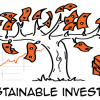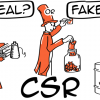Script
Creating sustainable value (for a business)
How does sustainability create value for a business? This is a critical question to answer if we are hoping a business is going to make positive progress on sustainability. In a previous video we looked at the work of Bob Willard on the business case for sustainability. Here is another tool that can be helpful to answer this question: the Sustainable Value Framework.
In 2003, the journal of the Academy of Management Executive published an article authored by Stuart L. Hart and Mark B. Milstein entitled, Creating Sustainable Value. While many businesses see sustainability as a cost, Hart and Milstein argue that, when viewed through the right set of business lenses, sustainability can actually help organizations drive value creation while addressing some of our most pressing challenges. This is what they define as sustainable value and put together in a two-by-two matrix, it is their Sustainable Value Framework:
The vertical axis represents time, with the present at the bottom and the future at the top. The horizontal axis represents the organization, with the internal perspective on the left and the external one on the right. According to Hart and Milstein, most businesses create value in the four quadrants defined in this matrix. Let’s drill down.
From a straight business perspective – nothing about sustainability yet, remember – here’s what they say.
- In the lower left quadrant, internally and in the near term, managing costs and reducing exposure to risk drives value for a business.
- In the lower right, externally, but also in the near-term, making sure a business maintains legitimacy and enhances reputation with external stakeholders creates value, too – a business can differentiate itself when it has credibility with its stakeholders.
- Moving into the upper left-quadrant, innovating and repositioning itself in light of changing conditions creates value for a business that remains mindful of the need to continually create the ‘products and services of the future’.
- And finally, in the upper right quadrant, the external dimensions of future performance are addressed – a clear future growth path and trajectory creates value for a business by offering new services or tapping into un-served markets. .
Taken together, these four quadrants are one way to define how a business creates value for its shareholders. Let’s see what happens when we apply a sustainability overlay to this business lens.
- In the lower left quadrant, engaging employees to find ways to reduce waste of all kinds and use resources more efficiently can radically lower operating costs, reduce exposure to risk and engage and energize the workforce.
- In the lower right quadrant, engaging with the immediate and extended value chain to develop product stewardship and extend the life and value of products and services can enhance the reputation and legitimacy of a business, thus enhancing value creation for the business.
- In the upper left quadrant, applying a sustainability lens can drive innovation and reposition the business by helping it to develop sustainable competency, identify the new skills, products and services that will be required in a resource-constrained society.
- Finally, when charting a future trajectory and communicating a vision for the future, a business can define a clear sustainability vision for itself, thereby facilitating competitive imagination and providing guidance regarding organizational priorities. This in turn can help meet unmet needs, identify new markets, including those previously under- or –un-served.
Businesses wondering if and how they should embed sustainability into their business strategy can use this framework to determine their activity in each of the four quadrants; identify whether there is an imbalance in their portfolio of activities; where and how the firm is best positioned to take action. Then they can develop a set of initiatives designed to balance the portfolio of activities and create new value for the business – while responding to the sustainability challenge.
There you have it, Hart and Milstein’s Sustainable Value Framework! Stay tuned for future videos on additional tools to help businesses capture the sustainability value proposition. If sustainability is important to you, please subscribe and check out our Patreon page to donate $1 or more per new video. As always, thanks to our patrons, we couldn’t do it without you. And thank you for watching!







One Comment